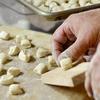I was comparing our recipe and techniques for pizza dough with a friend when she suddenly asked me why I bothered to proof my yeast before making the dough. I confess that I was caught off guard by this question. It is something I’ve done since I first started baking bread never realizing that it was optional. I would hate to go through all the trouble and waste of making the dough only to end up with a dud!
Proofing the yeast helps to hydrate active dry yeast and test to ensure the yeast is viable. This process should be done before adding carbohydrates (flour) to the yeast. When proofing yeast, I usually measure out the amount of warm water (or milk for brioche) called for in the recipe, add the sugar (up to 1 tablespoon) called for and stir to dissolve the sugar a bit. Yeast is happiest at about 75°-80°, so the water should feel barely warm or lukewarm to the touch. Resist the urge to use warmer water else you risk killing the yeast. I then sprinkle the yeast over the top of the liquid and give it a quick stir.
Letting the yeast sit in the sugar water for a few minutes, you should begin to see the dry granules release the active yeast inside. The yeast will then start feeding on the sugar and a frothy foam will appear on the surface of the liquid. This is caused by the carbon dioxide being released. This spume is proof that the yeast is active and ready to be added to the other ingredients to form your bread dough.
Food & Drink Magazine
Author's Latest Articles
-
Oh, What a Tangled Web We Weave…
-
Fabulous Favas of Fall
-
Celebrate St. Lucia Day
-
Old School Baked Custard

